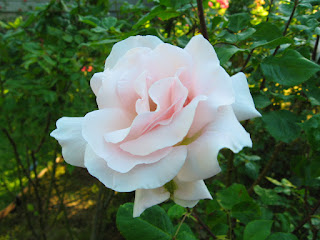This, by the way, is the sixth anniversary of this blog; the first post was on December 5, 2011. Herein, nature and digital photography have merged into an art form. My garden guardian The Chicken, shown below on the left, has been with me for 20 years, and is itself a work of art. The wild turkeys that have been roaming the neighborhood are life imitating art; I took their photo in October.
 | |
| The Chicken (photo taken: December 5, 2017) |
 |
| Wild Turkeys (photo taken: October 22, 2017) |
Update of December 27, 2017: Let's flip sides and say that "Art imitates life". Such is the case in the following 2 photos, where I first selected one of my better photos (from way back in 2015) and then processed the photo through a great photo editor & art facilitator. Many thanks to photofuneditor.com for providing the software -- the result below is rather striking --
 |
| A pretty rose cluster (photo taken: June 28, 2015) |
 |
| Art imitating life (created: December 26, 2017) |


























